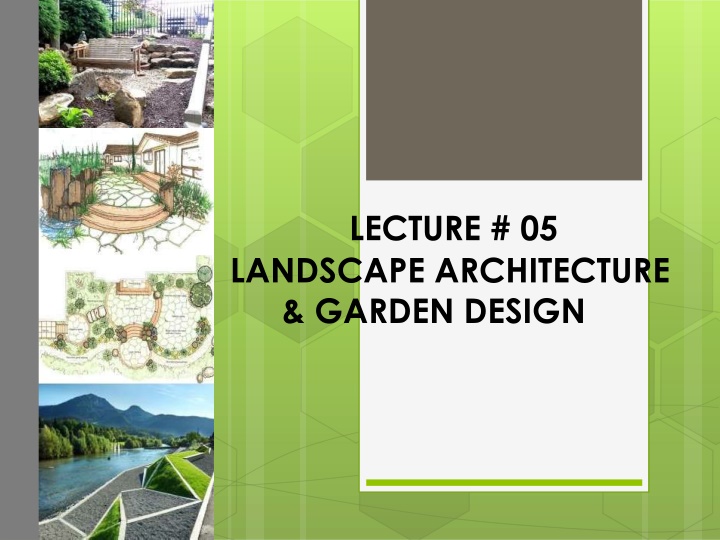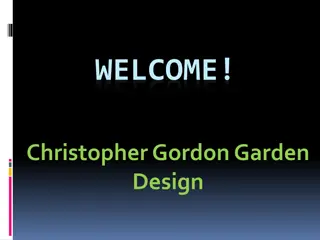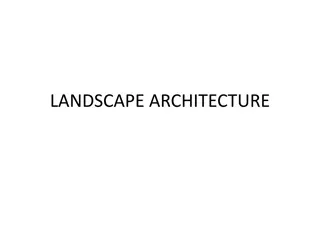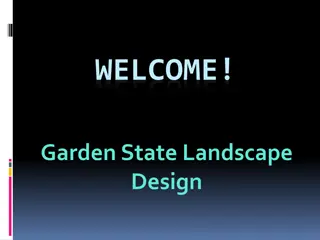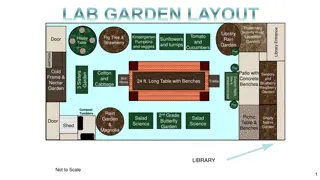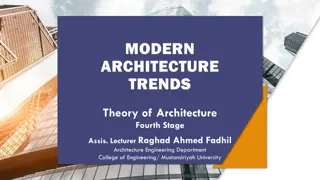LECTURE # 05 LANDSCAPE ARCHITECTURE & GARDEN DESIGN
Landscaping involves modifying land features to create aesthetic and functional outdoor spaces. Landscape architecture blends ancient garden design with modern practices to shape man-made environments. The profession encompasses urban design, site planning, environmental restoration, and parks development. Urban design focuses on large-scale elements to make cities sustainable and attractive.
Download Presentation

Please find below an Image/Link to download the presentation.
The content on the website is provided AS IS for your information and personal use only. It may not be sold, licensed, or shared on other websites without obtaining consent from the author.If you encounter any issues during the download, it is possible that the publisher has removed the file from their server.
You are allowed to download the files provided on this website for personal or commercial use, subject to the condition that they are used lawfully. All files are the property of their respective owners.
The content on the website is provided AS IS for your information and personal use only. It may not be sold, licensed, or shared on other websites without obtaining consent from the author.
E N D
Presentation Transcript
LECTURE # 05 LANDSCAPE ARCHITECTURE & GARDEN DESIGN
What is Landscaping? Landscape is more than just scenery. Land means both a place and the people living there. Scape means to shape , and also mean association, partnership.
What is Landscaping? The design of outdoor spaces of residences, commercial and any institutional area in order to achieve environmental and aesthetic standards is known as landscaping. It refers to any activity that modifies the visible features of an area of land, including: Living elements flora or fauna. Natural elements such as landforms, elevation, or bodies of water; Human elements such as structures, buildings, fences or other material objects created/installed by humans; and Abstract elements such as the weather and lighting conditions.
Landscape Architecture The name "landscape architecture" was invented by a Scotsman in 1828. It uses the ancient skill of garden designers (to compose landform with water, vegetation, structures and paving) and applies this skill to the man- made landscape. As Sir Geoffrey Jellicoe wrote in The landscape of man (1975): 'It is only in the present century that the collective landscape has emerged as a social necessity. We are promoting a landscape art on a scale never conceived of in history'. Landscape architecture is set fair to become the mother of the arts.
Scope of Landscape Architecture Landscape architecture involves the systematic investigation of existing social, ecological, and geological conditions and processes in the landscape. The scope of the profession includes: Urban Design Site Planning Environmental Restoration Parks and Recreational Planning
Scope of Landscape Architecture Urban Design An urban establishment has to contain strategic landscaping elements composition. These elements include green belts along roads, hard and soft shading devices, parks and pedestrian pathways. In contrast to architecture, which focuses on the design of individual buildings, urban design deals with the larger scale of groups of buildings, streets and public spaces, whole neighborhoods and districts, and entire cities, with the goal of making urban areas functional, attractive, and sustainable. integrated in its
Site Planning The site of any residential, commercial and office building must be incorporated with landscaping elements like trees, creepers, plants and paved floors/walkways externally. Environmental Restoration Trees produce oxygen and reduce greenhouse effect. To keep environment healthy and carbon free plantation should always be given significant attention. Parks and Recreation Planning Recreational planning in form of parks, walk/jogging tracks, leisure outdoor sitting spaces contribute towards making an comfortable. urban commodity more
Key Elements of Landscape Architecture Hardscape elements The term hardscape is used to describe the construction materials which are used to improve a landscape by design. A wide range of hard landscape materials can be used, such as brick, gravel, rock or stone, concrete, timber, bitumen, glass, metals, etc. Hardscape can also describe outdoor furniture and other landscape products.
Key Elements of Landscape Architecture Softscape elements The term softscape is used to describe the vegetative materials which are used to improve a landscape by design. The wide range of soft landscape materials include each layer of the ecological sequence: aquatic plants, semi- aquatic plants, field layer plants (including grasses & plants), shrubs and trees. Trees may be: Ornamental Shady
Creepers Shrubs Climbers Covered pathways
Key Elements of Landscape Architecture Water Bodies Water, which is a natural element, is also another most important and prominent landscape element. Water bodies improve the quality and the worth of the site. It makes the site attractive. The wide range of water bodies include fountains, pools, ponds, spouts and functional faucets, sprinkles, artificial waterfalls, etc.
Key Elements of Landscape Architecture Landmark A Landmark is a recognizable natural or artificial feature used for navigation, a feature that stands out from its nears environment and is often visible from long distances. It may be: Functional (e.g. Brick clock tower, Ghazeebo) Ornamental
Energy-efficient Landscaping The landscaping designed for the purpose of conserving energy is known as energy efficient landscaping. The key purpose of plantation is to provide shade and reduce hear in our country. Any effort in this respect will help in reducing energy/ electricity consumption. This is referred as an energy-efficient landscaping technique. Some of the other design techniques include: Planting trees for the purpose of providing shade, which reduces cooling costs. Planting or building windbreaks to slow winds near buildings, which reduces the heat.
Energy-efficient Landscaping Wall sheltering, where shrubbery or vines are used to create a windbreak directly against a wall. Green roofs that cool buildings. Site lighting with full cut off fixtures, light level sensors, and high efficiency fixtures. Local materials should be include to achieve cost effective landscape design.
Landscape Architecture & Garden Design Landscape architect and garden designers are concerned for the planning and design of outdoor spaces. The key difference is that landscape architects normally works for public clients while garden designers tend to work for homeowners. The range of work undertaken by landscape architect extends from detailed design to broad scale landscape planning.
